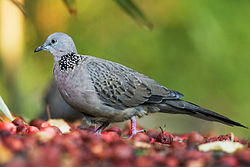| Spilopelia | |
|---|---|
 | |
| Spotted dove (S. chinensis) with plumage pattern of S. c. tigrina | |
| Scientific classification | |
| Domain: | Eukaryota |
| Kingdom: | Animalia |
| Phylum: | Chordata |
| Class: | Aves |
| Order: | Columbiformes |
| Family: | Columbidae |
| Subfamily: | Columbinae |
| Genus: | Spilopelia Sundevall, 1873 |
| Species | |
See text | |
| Synonyms | |
Stigmatopelia Sundevall, 1873 | |
Spilopelia is a genus of doves that are closely related to Streptopelia and Nesoenas , but distinguished from them by differences in morphology and genetics. Some authors [1] had argued that Stigmatopelia is the valid name as it appears in an earlier line of the same work by the Swedish zoologist Carl Sundevall, [2] [a] but Richard Schodde and Ian J. Mason had earlier, in their 1999 zoological catalogue of Australian birds, chosen Spilopelia in treating these two names as applying to the same genus; their choice stands under clause 24(b) of the International Code of Zoological Nomenclature (ICZN) which supports the decision of the first reviser. [4] [5] The name Spilopelia combines the Ancient Greek spilos meaning "spot" and peleia meaning "dove". [6]
Contents
| A phylogenetic position based on Johnson et al. (2001). A second possibility is that Columba is a sister of Streptopelia but the remaining clades appear to be monophyletic. [7] |


